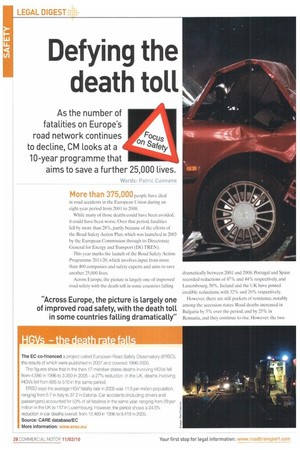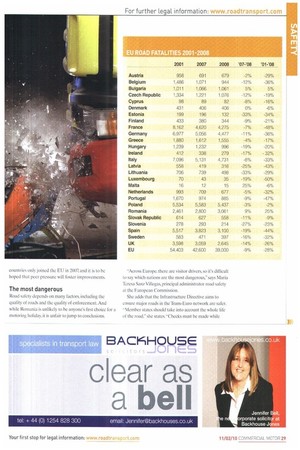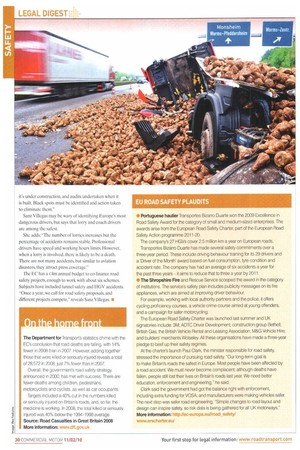Defying the death toll
Page 28

Page 29

Page 30

If you've noticed an error in this article please click here to report it so we can fix it.
As the number of fatalities on Europe's road network continues to decline, CM looks at a 10-year programme that aims to save a further 25,000 lives.
Words: Patric Cunnane More than 375,000 people have died in road accidents in the European Union during an eight-year period from 2001 to 2008.
While many of those deaths could have been avoided. it could have been worse. Over that period, fatalities fell by more than 28%, partly because of the efforts of the Road Safety Action Plan, which was launched in 2003 by the European Commission through its Directorate General for Energy and Transport (DO TREN).
This year marks the launch of the Road Safety Action Programme 2011-20, which involves input from more than 400 companies and safety experts and aims to save another 25,000 lives.
Across Europe, the picture is largely one of improved road safety with the death toll in some countries failing dramatically between 2001 and 2008. Portugal and Spain recorded reductions of 47% and 44% respectively, and Luxembourg, 50%. Ireland and the UK have posted credible reductions, with 32% and 26% respectively.
However, there are still pockets of resistance, notably among the accession states. Road deaths increased in Bulgaria by 5% over the period, and by 25% in Romania, and they continue to rise. However, the two countries only joined the EU in 2007, and it is to be hoped that peer pressure will foster improvements.
The most dangerous
Road safety depends on many factors, including the quality of roads and the quality of enforcement. And while Romania is unlikely to he anyone's first choice for a motoring holiday, it is unfair to jump to conclusions. "Across Europe. there are visitor drivers, so it's diflieult to say which nations are the most dangerous," says Maria Teresa San7Villegas, principal administrator road safety at the European Commission.
She adds that the Infrastructure Directive aims to ensure major roads in the Trans-Euro network are safer. "Member states should take into account the whole life of the road,she states. "Checks must be made while
its under construction, and audits undertaken when it is built. Black spots must be identified and action taken to eliminate them."
Sanz Villegas may be wary of identifying Europe's most dangerous drivers, but says that lorry and coach drivers arc among the safest.
She adds: "The number of lorries increases but the percentage of accidents remains stable. Professional drivers have speed and working hours limits. However, when a lorry is involved, there is likely to be a death. There are not many accidents, but similar to aviation disasters, they attract press coverage,
The EC has a &Inn annual budget to co-finance road safety projects, enough to work with about six schemes, Subjects have included tunnel safety and HGV accidents "Once a year, we call for road safety proposals, and different projects compete," reveals Sanz Villegas. •




































































































































